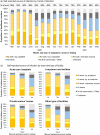SARS-CoV-2 infection among healthcare workers: the role of occupational and household exposures during the first three pandemic waves in Quebec, Canada
- PMID: 38028905
- PMCID: PMC10654992
- DOI: 10.1017/ash.2023.442
SARS-CoV-2 infection among healthcare workers: the role of occupational and household exposures during the first three pandemic waves in Quebec, Canada
Abstract
Objective: We described the evolution of SARS-CoV-2 source of infection in a cohort of healthcare workers (HCWs) of Quebec, Canada, during the first three pandemic waves. We also estimated their household secondary attack rate (SAR) and its risk factors.
Design: Cross-sectional surveys.
Participants: HCWs with a SARS-CoV-2 infection confirmed by polymerasa chain reaction and diagnosed between March 2020 and May 2021.
Methods: We collected demographic, clinical, vaccination, and employment information, self-reported perceived source of infection, and transmission to household members during the first three pandemic waves. SAR was calculated for households with ≥2 members where the HCW was the index case. A Poisson regression model estimated the association between risk factors and SAR.
Results: Among the 11,670 HCWs completing the survey, 91%, perceived their workplace as the source of infection during the first wave (March-July 2020), 71% during the second wave (July 2020-March 2021), and 40% during the third wave (March-May 2021). Conversely, HCWs reported an increasing proportion of household-acquired infections with each wave from 4% to 14% and 33%, respectively. The overall household SAR of 7,990 HCWs living with ≥1 person was 30% (95%CI: 29-30). SAR increased with the presence of symptoms, older age, and during Alpha-variant predominant period.
Conclusions: HCWs and their household members were largely affected during the first pandemic waves of COVID-19, but the relative importance of occupational exposure changed overtime. Pandemic preparedness in healthcare settings is essential to protect HCWs from emerging biological hazard exposures.
© Cambridge University Press 2023.
Conflict of interest statement
SC and GDS report funding from the Ministère de la santé et des services sociaux du Québec to conduct this work, paid to their institution. GD reports participation as a medical advisor on the provincial public health scientific committee on COVID-19 for Quebec Ministry of Health. DT is supported by a research career award from the Fonds de recherche du Québec-Santé, paid to his institution. All other authors report no potential conflicts.
Figures




Similar articles
-
Risk of SARS-CoV-2 infection before and after the Omicron wave in a cohort of healthcare workers in Ontario, Canada.BMC Infect Dis. 2025 Feb 7;25(1):183. doi: 10.1186/s12879-025-10580-8. BMC Infect Dis. 2025. PMID: 39920611 Free PMC article.
-
Characterization and evolution of infection control practices among severe acute respiratory coronavirus virus 2 (SARS-CoV-2)-infected healthcare workers in acute-care hospitals and long-term care facilities in Québec, Canada, Spring 2020.Infect Control Hosp Epidemiol. 2022 Apr;43(4):481-489. doi: 10.1017/ice.2021.160. Epub 2021 Apr 15. Infect Control Hosp Epidemiol. 2022. PMID: 33853702 Free PMC article.
-
Transmission of severe acute respiratory coronavirus virus 2 (SARS-CoV-2) between hospital workers and members of their household: Nationwide, registry-based, cohort study from Norway.Infect Control Hosp Epidemiol. 2023 Apr;44(4):604-609. doi: 10.1017/ice.2022.108. Epub 2022 Apr 29. Infect Control Hosp Epidemiol. 2023. PMID: 35485709
-
Parallel evolution and differences in seroprevalence of SARS-CoV-2 antibody between patients with cancer and health care workers in a tertiary cancer centre during the first and second wave of COVID-19 pandemic: canSEROcov-II cross-sectional study.Eur J Cancer. 2022 Apr;165:13-24. doi: 10.1016/j.ejca.2022.01.005. Epub 2022 Feb 1. Eur J Cancer. 2022. PMID: 35189537 Free PMC article.
-
COVID-19 infection and the broader impacts of the pandemic on healthcare workers.Respirology. 2022 Jun;27(6):411-426. doi: 10.1111/resp.14208. Epub 2022 Jan 19. Respirology. 2022. PMID: 35048469 Review.
Cited by
-
Risk factors for infection with SARS-CoV-2 in a cohort of Canadian healthcare workers: 2020-2023.Epidemiol Infect. 2025 Jun 23;153:e72. doi: 10.1017/S0950268825100101. Epidemiol Infect. 2025. PMID: 40548383 Free PMC article.
-
Anti-SARS-CoV-2 Antibody Levels in a Cohort of Health Care Workers Before and After the Omicron Wave in Canada.J Assoc Med Microbiol Infect Dis Can. 2025 May 29;10(2):127-145. doi: 10.3138/jammi-2024-0029. eCollection 2025 Jun. J Assoc Med Microbiol Infect Dis Can. 2025. PMID: 40673053 Free PMC article.
References
LinkOut - more resources
Full Text Sources
Miscellaneous
